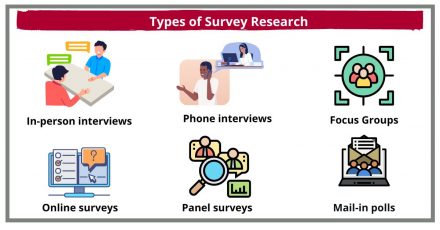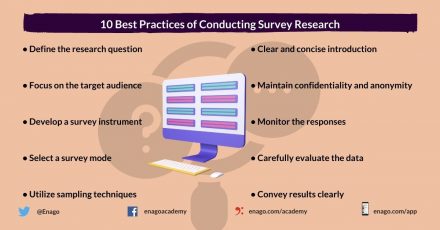Exploring the Power of Survey Research: 10 best practices to follow

From political polls to surveys of customer satisfaction, survey research has become ingrained in our daily lives, influencing how we perceive the world and the choices we make. In a world where data reigns supreme and information commands power, survey research is the crown jewel of research. Surveys have become a staple in the toolkit of researchers seeking to comprehend the complexities of human behavior and attitudes due to its capacity to collect a large amount of information from diverse populations. However, what exactly is survey research and what makes it such an effective research tool? Let’s find out!
What Is Survey Research?
Survey research is a strategy for gathering information from a gathering of people utilizing a normalized poll or study. In the social sciences, marketing, psychology, and healthcare industries, this kind of research is frequently used to learn about people’s thoughts, feelings, actions, and experiences.
Most of the time, a survey is made up of a set of questions that are meant to get specific information from the people who take it. Depending on the kind of data that needs to be gathered, the questions can be closed-ended or open-ended.
Open-ended questions allow for more in-depth and nuanced responses, whereas closed-ended questions give respondents a limited number of options for their responses.
What Is the Purpose of Survey Research?
Survey research aims to gather information from a small number of people in order to draw conclusions about a larger group. A wide range of topics, including attitudes, beliefs, behaviors, preferences, and opinions, can be gathered through surveys.
The essential objective of survey research is to get exact and dependable information that can be investigated to make significant determinations. The following are some of the primary purposes for conducting survey research;
- to learn more about the wants and needs of subjects,
- to gauge public opinion regarding concerning issues,
- to collect data for academic analysis and research,
- to determine whether or not public programs or policies are working,
- to gather information regarding health-related attitudes and behaviors,
- to determine employee engagement and satisfaction in the workplace, and many more.
What Are the Advantages of Survey Research?
- Collecting information: Large-scale surveys can yield a significant amount of data that can be analyzed to uncover insights into a variety of topics.
- Cost-effective and efficient: When compared to other methods of data collection, such as in-person interviews or focus groups, surveys frequently offer advantages in both efficiency and cost.
- Simple methodology: Surveys are a flexible and simple method for collecting data because they can be conducted online, over the phone, or in person.
- Anonymity: Because surveys can be taken anonymously, respondents are more likely to give honest answers.
- Consistent data collection: Overviews are commonly normalized, and that implies that all respondents are posed similar inquiries similarly, making it simpler to look at and examine information.
- Quantitative data analysis: Reviews frequently create information that can be investigated quantitatively, which considers factual examination and the distinguishing proof of patterns and examples.
- Typical of a broader population: Researchers can draw conclusions and make predictions about the attitudes and behaviors of a larger population by designing surveys to be representative of that population.
What Are the Limitations of Survey Research?
Despite the fact that it can be an effective method for gathering data, it does have some drawbacks. The following are some of the most typical drawbacks of carrying out survey research:
- Response bias: Due to social desirability bias, which is the tendency to answer questions in a way that makes one look good, respondents may not provide honest or accurate responses. As a result, data and outcomes may be skewed.
- Sampling bias: It is possible that the sample doesn’t accurately reflect the population, which could result in biased or inaccurate findings. This can occur when certain groups in the sample are either underrepresented or overrepresented.
- Scope restricted: It is possible that surveys many not be able to cover every aspect of a problem or phenomenon. Respondents may not be able to fully express their thoughts or feelings on a subject because surveys are limited to the questions that are asked.
- Problems with question design: It can be hard to make survey questions that work. Inaccurate responses and confusion can result from poorly phrased or ambiguous questions.
- Problems with online surveys: While the use of online surveys has increased in recent years, there are some drawbacks. Online overviews may not be available to all people, and there might be worries about information security and protection.
- Inadequate Capacity to ascertain causality: The ability of surveys to prove causality is limited. Surveys are able to identify patterns and correlations, but they are unable to demonstrate causation.
Researchers can design surveys that are more effective and accurately interpret the results if they are aware of these limitations.
What Are the Types of Survey Research?
There are different kinds of survey research, each of which has its own set of benefits and drawbacks. The most typical kinds of survey research are as follows:
- In-person interviews: Researchers conduct face-to-face interviews with respondents in person. This kind of survey research can be useful for obtaining in-depth responses, allowing researchers to clarify questions and investigate for additional information. However, it can be costly and time-consuming to carry out.
- Phone interviews: Interviews with respondents are conducted over the phone in telephone surveys. In comparison to in-person interviews, this kind of survey research can be carried out more quickly and at a lower cost. However, it may be challenging to collect in-depth responses, and some individuals may be reluctant to take part in phone surveys.
- Focus groups: A focus group is a method in which a select few respondents are brought together to discuss a specific topic or issue. In-depth information can be gathered and complex issues investigated with the help of this kind of survey research. However, because respondents may be influenced by the opinions of others in the group, it can be challenging to apply the findings of a focus group to a larger population.
- Online surveys: This is a cost-effective way to collect data from a large number of respondents. They are carried out over the internet. Additionally, this kind of survey research may permit anonymity, which may result in responses that are more honest. However, self-reported data’s accuracy and reliability may be questioned, and online surveys may not be representative of the entire population.
- Panel surveys: Over time, data are gathered from the same group of respondents for panel surveys. When it comes to keeping track of changes in attitudes and behaviors over time, this kind of survey research can be useful. Panel surveys, on the other hand, can be costly and may experience attrition, in which participants withdraw from the study over time.
- Mail-in polls: Respondents in mail surveys are provided with questionnaires. Although response rates can be low and self-reported data’s accuracy and reliability may be questioned, this kind of survey research can be cost-effective.
What Are the Best Practices of Conducting Survey Research?
When conducting surveys for research, it is necessary to adhere to best practices to guarantee the accuracy, dependability, and validity of the data. The following are some best practices for research surveys:
- Define the research question in detail: It is essential to have a clearly defined research question that specifies the specific information that must be gathered prior to conducting a survey.
- Define the people you want to reach: It’s important to clearly define the survey’s target audience. For accurate results, the sample being surveyed must be representative of the intended population.
- Create the instrument for the survey: The research question and target audience should serve as the foundation for the development of the survey instrument, including its questions and response options. It is critical to test the overview instrument before use to guarantee it is straightforward and produces exact outcomes.
- Select the right survey mode: The research question, target audience, and budget should all be taken into consideration when selecting the survey mode. Online, telephone, in-person, and postal surveys are the most common survey formats.
- Utilize sampling techniques: To select a representative sample from the intended population, sampling techniques should be used. Random sampling and stratified sampling are two common sampling techniques.
- Use a survey introduction that is clear and concise: Respondents ought to be given an introduction to the survey that is both clear and brief. It ought to include details about the survey’s purpose, how the data will be used, and how long it will take to complete.
- Maintain confidentiality and anonymity: Respondents ought to be guaranteed of obscurity and secrecy to energize fair and precise reactions.
- Keep an eye on responses: To ensure that a representative sample is obtained, response rates should be monitored. A biased sample may result from low response rates.
- Carefully evaluate the data: After the data has been gathered, it should be carefully examined to find patterns and trends. To guarantee the accuracy and dependability of the analysis, statistical software should be used.
- Convey results really: To ensure that the intended audience comprehends the information, the survey results should be effectively communicated. Preparing a report, presenting the findings at a conference or meeting, or publishing the findings in a scientific journal are all examples of this.
What Is the Importance of Ethical Considerations in Survey Research?
Protecting the rights and well-being of study participants and ensuring the validity and reliability of the collected data necessitate ethical considerations. Ethical considerations are crucial to survey research for the following reasons:
- Protecting the rights of participants: During the course of the research, ethical considerations assist in ensuring that participants are treated with dignity and respect and that their rights are safeguarded. This includes obtaining participants’ informed consent, maintaining anonymity and confidentiality, and disclosing the research’s purpose, potential risks, and benefits.
- Validity and reliability of the data: Moral contemplations are significant for guaranteeing the legitimacy and dependability of the information gathered. This incorporates guaranteeing that the example is illustrative of the objective populace, utilizing legitimate and dependable overview instruments, and limiting the potential for predisposition and blunder in information assortment and examination.
- Keeping the public’s faith: Maintaining public confidence in research and researchers is made easier by ethical considerations. Research that is directed morally and straightforwardly is bound to be viewed as dependable and tenable by the general population, which can assist with advancing proceeded with cooperation in exploration and backing for logical examination overall.
- Following professional guidelines: When it comes to adhering to professional standards and conduct codes, ethical considerations are crucial. Researchers are expected to adhere to ethical research practices by professional organizations and regulatory bodies frequently.
- Preventing harm: Participants, researchers, and other stakeholders all benefit from being protected from harm when ethical considerations are taken into account. This includes ensuring that research is carried out in a manner that is socially responsible and accountable, avoiding conflicts of interest, and minimizing risks for participants.
How to Develop Good Survey Research Questions?
Creating good survey research questions is a crucial step in making an impactful survey that provides comprehensive analysis. Here is how you can create an impactful survey research questionnaire:
- Determine the survey’s objective: The purpose of the survey must first be established. You need to know why the survey is being done and what kind of data you want to get. This will assist you in determining the most important subjects and survey questions.
- Examine past research: Review the existing research on the subject prior to developing your survey questions. This will assist you in filling in any gaps in the existing research and guaranteeing the usefulness and relevance of your survey questions.
- Identify important topics and themes: Identify the primary themes and topics that you want to explore in the survey based on the purpose of the survey and existing research. The questions for your survey will be based on these.
- Create open-ended questions: Start by creating open-ended questions that encourage thoughtful and in-depth responses from respondents. To encourage respondents to share their thoughts and ideas, these questions ought to be inclusive and broad.
- Create closed-ended questions: You can then create closed-ended questions after developing your open-ended ones. The structure of these questions ought to include options for responses that are consistent and simple to comprehend.
- Use simple and clear language: When developing your survey questions, use language that is both clear and concise. Avoid using technical jargon or lengthy sentences that respondents may find difficult to understand.
- Pilot test your questions: Pilot testing your survey questions is crucial after developing them. This will assist you in determining any issues with the questions and ensuring that they are pertinent, concise, and clear.
If you follow these steps, you can come up with good survey research questions that will help you get information that is useful and relevant.
How to Measure Concepts With Survey Research Questions?
The question wording, response options, and survey design all need to be carefully considered when measuring concepts with survey research questions. When using survey research questions to measure concepts, follow these important steps:
- Define the idea in detail: It is essential to have a concise and clear definition of the concept being measured prior to developing survey questions. This can assist with guaranteeing that overview questions precisely catch the expected importance of the idea.
- Use language that is concise and clear: Respondents should be able to easily comprehend the language used in the survey questions. Avoid using jargon or technical terms that respondents may not be familiar with.
- Make use of the appropriate responses: In order to accurately reflect the range of responses to the question, response options should be carefully selected. Likert scales, in which respondents can rate their level of agreement or disagreement with a statement, and multiple-choice options, in which respondents can select from a list of pre-defined options, are two common response options.
- Questions for the survey: It is essential to test survey questions with a small sample of respondents prior to conducting a survey. Before the survey is distributed to a larger sample, this can assist in identifying any issues with the design, response options, or wording of the questions.
- Think about the survey’s context: The context of the survey should be considered when developing survey questions. For instance, questions may need to be modified to accommodate various survey formats (such as online, telephone, or in-person) or populations (such as distinct age groups or cultural backgrounds).
- Use valid and reliable measures: Last but not least, in order to guarantee that survey questions accurately measure the intended concept, it is essential to employ reliable and valid measures. Valid measures accurately convey the intended concept, whereas reliable measures remain consistent and stable over time.
Survey research is a powerful tool for collecting large amounts of data to better understand human behavior and attitudes. While it has its limitations, survey research can yield accurate and reliable information that can be analyzed to make significant determinations. By following the 10 best practices explained in this article, researchers can design effective surveys that are representative of their population of interest and accurately interpret the results. So the next time you’re asked to take a survey, remember that your responses are helping to shape the world we live in, one data point at a time!












![What is Academic Integrity and How to Uphold it [FREE CHECKLIST]](https://www.enago.com/academy/wp-content/uploads/2024/05/FeatureImages-73.png)